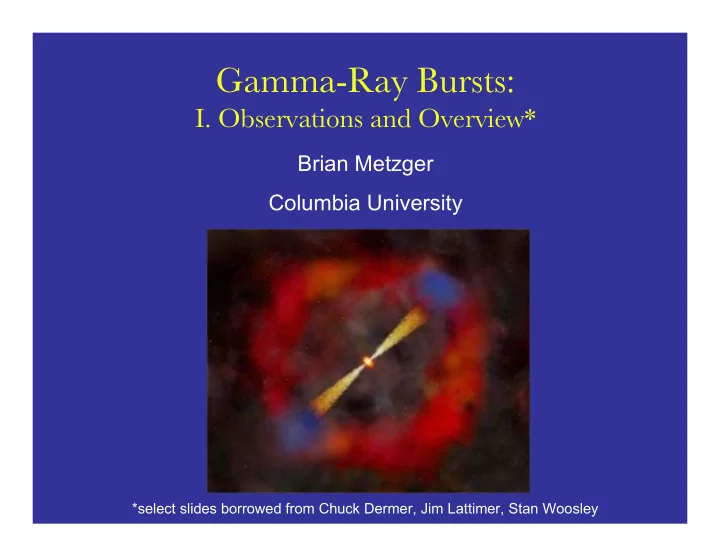

Gamma-Ray Bursts: I. Observations and Overview* Brian Metzger Columbia University *select slides borrowed from Chuck Dermer, Jim Lattimer, Stan Woosley
Blazar Pulsar AGN Globular Blazar Cluster
Gamma-Ray Bursts (GRBs) Variable `bursts’ of gamma-rays lasting milliseconds to minutes. Discovered by the VELA satellites in 1967 when monitoring nuclear test ban treaty (declassified 1972) GRBs occur about once per day across the whole sky. counts per second “When you’ve seen one GRB…. you’ve see one GRB”
Barraud et al. 2002 (keV)
Gamma-Ray Burst Durations long short Duration BATSE Bursts (from Nakar 2007)
High E peak ⇒
The Dark Ages (1972-1991) Gamma-rays are difficult to focus. The precise location of a GRB on the sky is difficult to pin down accurately. ‘Consensus’ opinion in the 1970s & 80s: GRBs come from within our Galaxy.
The Dark Ages (1972-1991) Gamma-rays are difficult to focus. The precise location of a GRB on the sky is difficult to pin down accurately. ‘Consensus’ opinion in the 1970s & 80s: Compton Gamma-Ray GRBs come from within our Galaxy. Observatory (1991-2000) The Milky Way “The Great Debate”
GRBs as Ultra-Relativistic Explosions Large (cosmological) distances ⇒ huge energies E γ ~ 10 51 -10 54 ergs ~ 10 -3 - 1M c 2 fast variability δ t var ~ 10 ms ⇒ compact source R max ~ c/ δ t var ~10 7 cm Γ ~ 100-1000 GRB Spectrum v ~ 0.99999 c E peak γ " + " # e $ + e +
Why GRBs must originate from relativistic outflows Zhang & Meszaros (2004) radius of 1st photon : R 1 = ct 1st photon leaves at t=0 radius of 2nd photon : R 2 = c ( t " # t ) + $ c # t …over which time the gamma-emitting 2nd photon leaves Δ t later.. shell has moved this distance $ ~1 2 # t / % 2 # t obs ~ ( R 1 " R 2 )/ c ~ (1 " $ ) # t ~
The Afterglow Revolution (~1997) • If GRBs originate from far away, they must be very energetic explosions. • Space is filled with tenuous gas. When the explosion runs into the gas, the resulting shock collisionless shock - A. Spitkovsky will accelerate electrons. This powers synchrotron emission from radio to X-rays.
The Afterglow Revolution (~1997) • If GRBs originate from far away, they must be very energetic explosions. • Space is filled with tenuous gas. When the explosion runs into the gas, the resulting shock collisionless shock - A. Spitkovsky will accelerate electrons. This powers synchrotron emission from radio to X-rays. Beppo Sax z > 0.835!
Deceleration of a Relativistic Jet Zhang & MacFadyen 2009 t 1 t 2 t 3 2 " syn # B $ e E = " # 2 r 3 = const t ~ r/2c # 2 $
Resolving the Radio Afterglow => Relativistic Motion Gehrels, Ramirez-Ruiz, & Fox 2009; data from Pihlstrom et al. 2008 z = 0.168; D A ~ 600 Mpc " = # ct ( ) mas D A ~ 0.2 # t 100 d $ # ~ 1 (days)
GRBs as Jetted Relativistic Explosions Once corrected for beaming, the true energies of GRBs are less extreme Jet Break jet opening angle Frail+01; Bloom+03 Θ jet ~ 5-10 o (ergs) (ergs)
Implications for the “Central Engine” • Rapid variability dt ~ 10 ms ⇒ R < c dt ~ 10 3 km • Relativistic velocities v ~ c • Huge energy release ~10 50 -10 52 ergs ~ 10 -4 -10 -2 M c 2 ⇒ Catastrophic birth or destruction of stellar mass compact objects (neutron stars or black holes) NS Circinus X-1 BH ~day 1 ~day 3 NS ~day 5 Fender et al. 2004
GRB Em Emission: S Still El Elusive! Relativistic Outflow ( Γ >> 1) ~ 10 7 cm Central Engine GRB / Flaring Afterglow 1. What is jet’s composition? (kinetic or magnetic?) 2. Where is dissipation occurring? (photosphere? deceleration radius?) 3. How is radiation generated? (synchrotron, inverse-compton, hadronic?)
Prompt Emission Models Internal Shocks (Synchrotron) • jet variability ⇒ internal collisions ⇒ shocks ⇒ particle acceleration + B field Piran 2004 amplification ⇒ synchrotron pros: shocks inevitable in variable flows cons: low radiative efficiency, requires fine tuning of shock parameters “Photospheric” Dissipation (IC Scattering) • GRB emission = thermal spectrum Comptonized (producing high energy power-law tail) by hot electrons near Giannios 2011 photosphere. pros: ~MeV spectral peak set by photosphere temperature (robust) cons: source of electron heating uncertain (shocks, collisions, reconnection)
~50 MeV - 100 GeV GLAST = Fermi
GBM (8 keV - 40 MeV) LAT (20MeV - 300 GeV) • Extreme Bursts (e.g. 080916C: E iso = 8.8 x 10 54 ergs ) • Distinct GeV Component – Delayed wrt MeV photons – Slow Decay ( ~ t -1.5 ) - Origin: Prompt? Afterglow? (e.g. Kumar & Barniol Duran 09; Ghirlanda+09) 090510 090902B (Fermi Collaboration 09) Ghirlanda et al. 2009
Beloborodov et al. 2011
X-Ray Afterglows in the Swift Era GRB Here Steep Decay Phase Gehrels, Ramirez-Ruiz & Fox 2009 Plateau Phase Late Flares ‘Canonical’ X-Ray Light Curve
Gamma-Ray Burst Durations long short Duration BATSE Bursts (from Nakar 2007)
GRB 030329 and the Supernova Connection Exploding “Wolf-Rayet” Star radius R~10 11 cm (3 light-seconds).
GRB 030329 and the Supernova Connection ⇒ Long GRBs come from the deaths of massive Stars Exploding “Wolf-Rayet” Star radius R~10 11 cm Gamma-Ray Burst Galaxies (3 light-seconds). (courtesy A. Fruchter)
Recommend
More recommend